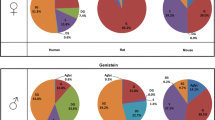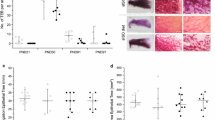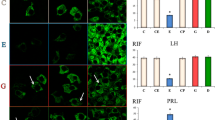Abstract
Genistein and daidzein are the main isoflavones in soy. Their potential beneficial or adverse effects in males like the prevention of prostate cancer or the impact on reproductive functions are controversially discussed. Major determinants of their bioactivity are the absorption and biotransformation of isoflavones. In this study, we focused on the influence of testosterone on plasma availability and phase II metabolism of isoflavones. Male Wistar rats, receiving an isoflavones rich diet, were randomized into three groups: Two groups were orchiectomized (ORX) at postnatal day (PND) 80 and treated for 11 days with testosterone propionate (TP) (ORX TP group) or a vehicle (ORX group) after a 7 days lasting hormonal decline. The third group served as control and remained intact. Rats were sacrificed at PND 98. ORX rats had reduced isoflavones plasma levels. Differently regulated mRNA expressions of transporters relevant for transport of phase II metabolites in liver and kidney may be responsible for this reduction, more precisely Slc10a1 and Slc21a1 in kidney as well as Slc22a8 in liver. While main phase II metabolites in intact rats were disulfates and sulfoglucuronides, the amount of sulfate conjugates was significantly diminished by ORX. In accordance with that, mRNA expression of different sulfotransferases was reduced in liver by ORX. The observed effects could be almost restored by TP treatment. In conclusion, testosterone, and likely further androgens, has a huge impact on phase II metabolism and availability of isoflavones by influencing the expression of different sulfotransferases and transporters.







Similar content being viewed by others
Abbreviations
- 1A:
-
Cytochrome-c-oxidase subunit 1A
- Abc:
-
ATP-binding cassette transporters
- Bcrp:
-
Breast cancer resistance protein
- DAI:
-
Daidzein
- DS:
-
Disulfate
- G:
-
Glucuronide
- GEN:
-
Genistein
- ISO:
-
Isoflavones
- Mrp:
-
Multidrug resistance-associated protein
- Ntcp:
-
Na+-taurocholate cotransporting polypeptide
- Oat:
-
Organic anion transporter
- Oatp:
-
Organic anion transporting polypeptide
- ORX:
-
Orchiectomy
- PND:
-
Postnatal day
- S:
-
Sulfate
- Slc:
-
Solute carrier
- Sult:
-
Sulfotransferase
- TP:
-
Testosterone propionate
- Ugt:
-
UDP-glucuronosyltransferase
References
Alnouti Y, Klaassen CD (2010) Mechanisms of gender-specific regulation of mouse sulfotransferases (Sults). Xenobiotica 41:187–197. doi:10.3109/00498254.2010.535923
Ando S, Aquila S, Beraldi E, Canonaco M, Panno ML, Valenti A, Dessi-Fulgheri F (1988) Physiological changes in androgen plasma levels with elapsing of time from castration in adult male rats. Horm Metab Res 20:96–99
Blanchard RL, Freimuth RR, Buck J, Weinshilboum RM, Coughtrie MW (2004) A proposed nomenclature system for the cytosolic sulfotransferase (SULT) superfamily. Pharmacogenetics 14:199–211
Blei T, Soukup ST, Schmalbach K, Pudenz M, Möller FJ, Egert B, Wörtz N, Kurrat A, Müller D, Vollmer G, Gerhäuser C, Lehmann L, Kulling SE, Diel P (2015) Dose-dependent effects of isoflavone exposure during early lifetime on the rat mammary gland: studies on estrogen sensitivity, isoflavone metabolism, and DNA methylation. Mol Nutr Food Res 59:270–283
Buckley DB, Klaassen CD (2009) Mechanism of gender-divergent UDP-glucuronosyltransferase mRNA expression in mouse liver and kidney. Drug Metab Dispos 37:834–840. doi:10.1124/dmd.108.024224
Buist SC, Klaassen CD (2004) Rat and mouse differences in gender-predominant expression of organic anion transporter (Oat1–3; Slc22a6–8) mRNA levels. Drug Metab Dispos 32:620–625
Buist SCN, Cherrington NJ, Choudhuri S, Hartley DP, Klaassen CD (2002) Gender-specific and developmental influences on the expression of rat organic anion transporters. J Pharmacol Exp Ther 301:145–151
Cederroth CR, Auger J, Zimmermann C, Eustache F, Nef S (2010) Soy, phyto-oestrogens and male reproductive function: a review. Int J Androl 33:304–316. doi:10.1111/j.1365-2605.2009.01011.x
Chen Y, Huang C, Zhou T, Zhang S, Chen G (2010) Biochanin A induction of sulfotransferases in rats. J Biochem Mol Toxicol 24:102–114. doi:10.1002/jbt.20318
Choudhuri S, Cherrington NJ, Li N, Klaassen CD (2003) Constitutive expression of various xenobiotic and endobiotic transporter mRNAs in the choroid plexus of rats. Drug Metab Dispos 31:1337–1345
Dunn RT, Klaassen CD (1998) Tissue-specific expression of rat sulfotransferase messenger RNAs. Drug Metab Dispos 26:598–604
Enokizono J, Kusuhara H, Sugiyama Y (2007) Effect of breast cancer resistance protein (Bcrp/Abcg2) on the disposition of phytoestrogens. Mol Pharmacol 72:967–975
Fang H, Tong W, Shi LM, Blair R, Perkins R, Branham W, Hass BS, Xie Q, Dial SL, Moland CL, Sheehan DM (2001) Structure-activity relationships for a large diverse set of natural, synthetic, and environmental estrogens. Chem Res Toxicol 14:280–294
Filipović B, Šošić-Jurjević B, Ajdžanović V, Brkić D, Manojlović-Stojanoski M, Milošević V, Sekulić M (2010) Daidzein administration positively affects thyroid C cells and bone structure in orchidectomized middle-aged rats. Osteoporos Int 21:1609–1616. doi:10.1007/s00198-009-1092-x
Gotoh Y, Kato Y, Stieger B, Meier PJ, Sugiyama Y (2002) Gender difference in the Oatp1-mediated tubular reabsorption of estradiol 17β-d-glucuronide in rats. Am J Physiol Endocrinol Metab 282:E1245–E1254
Grosser G, Döring B, Ugele B, Geyer J, Kulling SE, Soukup ST (2015) Transport of the soy isoflavone daidzein and its conjugative metabolites by the carriers SOAT, NTCP, OAT4, and OATP2B1. Arch Toxicol 89:2253–2263. doi:10.1007/s00204-014-1379-3
Islam MA, Bekele R, vanden Berg JHJ, Kuswanti Y, Thapa O, Soltani S, van Leeuwen FXR, Rietjens IMCM, Murk AJ (2015) Deconjugation of soy isoflavone glucuronides needed for estrogenic activity. Toxicol In Vitro. doi:10.1016/j.tiv.2015.01.013
Juma SS, Ezzat-Zadeh Z, Khalil DA, Hooshmand S, Akhter M, Arjmandi B (2012) Soy protein with or without isoflavones failed to preserve bone density in gonadal hormone–deficient male rat model of osteoporosis. Nutr Res 32:694–700. doi:10.1016/j.nutres.2012.08.001
Kato K, Kusuhara H, Kumagai Y, Ieiri I, Mori H, Ito S, Nakai Y, Maeda K, Sugiyama Y (2012) Association of multidrug resistance-associated protein 2 single nucleotide polymorphism rs12762549 with the basal plasma levels of phase II metabolites of isoflavonoids in healthy Japanese individuals. Pharmacogenet Genomics 22:344–354
Keinan-Boker L, Peeters P, Mulligan A, Navarro C, Slimani N, Mattisson I, Lundin E, McTaggart A, Allen NE, Overvad K, Tjønneland A, Clavel-Chapelon F, Linseisen J, Haftenberger M, Lagiou P, Kalapothaki V, Evangelista A, Frasca G, Bueno-de-Mesquita HB, van der Schouw YT, Engeset D, Skeie G, Tormo MJ, Ardanaz E, Charrondière UR, Riboli E (2002) Soy product consumption in 10 European countries: the European Prospective Investigation into Cancer and Nutrition (EPIC) study. Public Health Nutr 5:1217. doi:10.1079/PHN2002400
Khalil DA, Lucas EA, Smith BJ, Soung DY, Devareddy L, Juma S, Akhter MP, Recker R, Arjmandi BH (2005) Soy isoflavones may protect against orchidectomy-induced bone loss in aged male rats. Calcif Tissue Int 76:56–62. doi:10.1007/s00223-004-0018-z
Kinjo J, Tsuchihashi R, Morito K, Hirose T, Aomori T, Nagao T, Okabe H, Nohara T, Masamune Y (2004) Interactions of phytoestrogens with estrogen receptors a and b (III). Estrogenic activities of soy isoflavone aglycones and their metabolites isolated from human urine. Biol Pharm Bull 27:185–188
Kishida T, Mizushige T, Nagamoto M, Ohtsu Y, Izumi T, Obata A, Ebihara K (2006) Lowering effect of an isoflavone-rich fermented soybean extract on the serum cholesterol concentrations in female rats, with or without ovariectomy, but not in male rats. Biosci Biotechnol Biochem 70:1547–1556. doi:10.1271/bbb.50008
Kojima M, Degawa M (2014) Sex differences in the constitutive gene expression of sulfotransferases and UDP-glucuronosyltransferases in the pig liver: androgen-mediated regulation. Drug Metab Pharmacokinet 29:192–197. doi:10.2133/dmpk.DMPK-13-RG-086
Liu L, Klaassen CD (1996) Ontogeny and hormonal basis of male-dominant rat hepatic sulfotransferases. Mol Pharmacol 50:565–572
Lu R, Kanai N, Bao Y, Wolkoff AW, Schuster VL (1996) Regulation of renal oatp mRNA expression by testosterone. Am J Physiol-Renal Physiol 270:F332–F337
Lund TD, Munson DJ, Haldy ME, Setchell KDR, Lephart ED, Handa RJ (2004) Equol is a novel anti-androgen that inhibits prostate growth and hormone feedback. Biol Reprod 70:1188–1195. doi:10.1095/biolreprod.103.023713
Messina M, Nagata C, Wu AH (2006) Estimated Asian adult soy protein and isoflavone intakes. Nutr Cancer 55:1–12. doi:10.1207/s15327914nc5501_1
Molzberger AF, Soukup ST, Kulling SE, Diel P (2013) Proliferative and estrogenic sensitivity of the mammary gland are modulated by isoflavones during distinct periods of adolescence. Arch Toxicol 87:1129–1140
Mortensen A, Kulling SE, Schwartz H, Rowland I, Ruefer CE, Rimbach G, Cassidy A, Magee P, Millar J, Hall WL, Birkved FK, Sorensen IK, Sontag G (2009) Analytical and compositional aspects of isoflavones in food and their biological effects. Mol Nutr Food Res 53:S266–S309
Müller DR, Basso F, Kurrat A, Soukup ST, Niehoff A, Kulling SE, Diel P (2016) Dose-dependent effects of isoflavone exposure during early lifetime on development and androgen sensitivity in male Wistar rats. Mol Nutr Food Res 60:325–336. doi:10.1002/mnfr.201500559
Nakano H, Ogura K, Takahashi E, Harada T, Nishiyama T, Muro K, Hiratsuka A, Kadota S, Watabe T (2004) Regioselective monosulfation and disulfation of the Phytoestrogens daidzein and genistein by human liver sulfotransferases. Drug Metab Pharmacokinet 19:216–226
Orgaard A, Jensen L (2008) The effects of soy isoflavones on obesity. Exp Biol Med 233:1066–1080. doi:10.3181/0712-MR-347
Owens W, Gray LE, Zeiger E, Walker M, Yamasaki K, Ashby J, Jacob E (2007) The OECD program to validate the rat hershberger bioassay to screen compounds for in vivo androgen and antiandrogen responses: phase 2 dose-response studies. Environ Health Perspect 115:671–678. doi:10.1289/ehp.9666
Pai TG, Suiko M, Sakakibara Y, Liu M-C (2001) Sulfation of flavonoids and other phenolic dietary compounds by the human cytosolic sulfotransferases. Biochem Biophys Res Commun 285:1175–1179
Perabo FGE, Von Löw EC, Ellinger J, von Rücker A, Müller SC, Bastian PJ (2008) Soy isoflavone genistein in prevention and treatment of prostate cancer. Prostate Cancer Prostatic Dis 11:6–12
Pfaffl MW (2001) A new mathematical model for relative quantification in real-time RT-PCR. Nucleic Acids Res 29:e45
Pugazhendhi D, Watson KA, Mills S, Botting N, Pope GS, Darbre PD (2008) Effect of sulphation on the oestrogen agonist activity of the phytoestrogens genistein and daidzein in MCF-7 human breast cancer cells. J Endocrinol 197:503–515
Sfakianos J, Coward L, Kirk M, Barnes S (1997) Intestinal uptake and biliary excretion of the isoflavone genistein in rats. J Nutr 127:1260–1268
Shelby MK, Cherrington NJ, Vansell NR, Klaassen CD (2003) Tissue mRNA expression of the rat UDP-glucuronosyltransferase gene family. Drug Metab Dispos 31:326–333
Soukup ST, Al-Maharik N, Botting N, Kulling SE (2014) Quantification of soy isoflavones and their conjugative metabolites in plasma and urine: an automated and validated UHPLC-MS/MS method for use in large-scale studies. Anal Bioanal Chem 406:6007–6020. doi:10.1007/s00216-014-8034-y
Soukup ST, Helppi J, Müller DR, Zierau O, Watzl B, Vollmer G, Diel P, Bub A, Kulling SE (2016) Phase II metabolism of the soy isoflavones genistein and daidzein in humans, rats and mice: a cross-species and sex comparison. Arch Toxicol 90:1335–1347. doi:10.1007/s00204-016-1663-5
The International Transporter Consortium (2010) Membrane transporters in drug development. Nat Rev Drug Discov 9:215–236
Urakami Y, Nakamura N, Takahashi K, Okuda M, Saito H, Hashimoto Y, Inui K (1999) Gender differences in expression of organic cation transporter OCT2 in rat kidney. FEBS Lett 461:339–342
Van Die MD, Bone KM, Williams SG, Pirotta MV (2014) Soy and soy isoflavones in prostate cancer: a systematic review and meta-analysis of randomized controlled trials: soy and soy isoflavones in prostate cancer. BJU Int 113:E119–E130. doi:10.1111/bju.12435
Wang SWJ, Kulkarni KH, Tang L, Wang JR, Yin T, Daidoji T, Yokota H, Hu M (2009) Disposition of flavonoids via enteric recycling: UDP-glucuronosyltransferase (UGT) 1As deficiency in gunn rats is compensated by increases in UGT2Bs activities. J Pharmacol Exp Ther 329:1023–1031. doi:10.1124/jpet.108.147371
Wang J, Xu J, Wang B, Shu FR, Chen K, Mi MT (2014) Equol promotes rat osteoblast proliferation and differentiation through activating estrogen receptor. Genet Mol Res 13:5055–5063. doi:10.4238/2014.July.4.21
Weigt C, Hertrampf T, Zoth N, Fritzemeier KH, Diel P (2012) Impact of estradiol, ER subtype specific agonists and genistein on energy homeostasis in a rat model of nutrition induced obesity. Mol Cell Endocrinol 351:227–238. doi:10.1016/j.mce.2011.12.013
Wong CC, Botting NP, Orfila C, Al-Maharik N, Williamson G (2011) Flavonoid conjugates interact with organic anion transporters (OATs) and attenuate cytotoxicity of adefovir mediated by organic anion transporter 1 (OAT1/SLC22A6). Biochem Pharmacol 81:942–949
Zhang Y, Song TT, Cunnick JE, Murphy PA, Hendrich S (1999) Daidzein and genistein glucuronides in vitro are weakly estrogenic and activate human natural killer cells at nutritionally relevant concentrations. J Nutr 129:399–405
Zhu W, Xu H, Wang SJ, Hu M (2010) Breast cancer resistance protein (BCRP) and sulfotransferases contribute significantly to the disposition of genistein in mouse intestine. AAPS J 12:525–536
Acknowledgments
The authors thank Dr. Alexander Roth for his support with the statistical analysis of the data and Ute Laudenbach-Leschowsky for her support during the conduction of the animal experiment. Parts of the work were funded by the German Research Foundation (DFG), Grant KU-1079/9-1 and DI-716/12-2. This DFG project is part of the collaborative research project entitled IsoCross “Isoflavones: Cross-species comparison of metabolism, estrogen sensitivity, epigenetics and carcinogenesis”.
Author information
Authors and Affiliations
Corresponding author
Ethics declarations
Conflict of interest
The authors declare that they have no conflict of interest.
Additional information
Sebastian T. Soukup and Dennis R. Müller have contributed equally to this work.
Parts of the work (body and prostate weights as well as food intake and ISO overall plasma levels, presented in this manuscript in Supplementary Fig. 1 and Table 2) were previously presented in the manuscript investigating the influence of ISO on development and androgen sensitivity in male rats (Müller et al. 2016).
Electronic supplementary material
Below is the link to the electronic supplementary material.
Rights and permissions
About this article
Cite this article
Soukup, S.T., Müller, D.R., Kurrat, A. et al. Influence of testosterone on phase II metabolism and availability of soy isoflavones in male Wistar rats. Arch Toxicol 91, 1649–1661 (2017). https://doi.org/10.1007/s00204-016-1853-1
Received:
Accepted:
Published:
Issue Date:
DOI: https://doi.org/10.1007/s00204-016-1853-1




